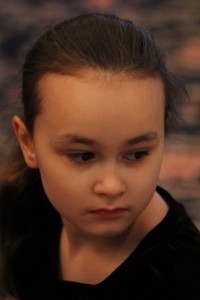Edward Willett's Blog, page 65
February 23, 2011
Once more into the breach
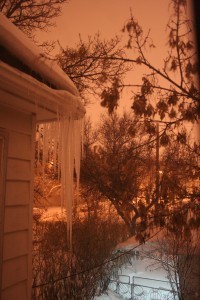 A while back I discussed a variety of ideas for new projects with my agent, Ethan Ellenberg. There was one in particular he liked, which is tentatively titled Masks. It's a YA fantasy, and since he's anxious to see some sample chapters, I've plunged into it.
A while back I discussed a variety of ideas for new projects with my agent, Ethan Ellenberg. There was one in particular he liked, which is tentatively titled Masks. It's a YA fantasy, and since he's anxious to see some sample chapters, I've plunged into it.
Here's how it begins:
A w eek before her thirteenth birthday and her Masking, Mara sat on the city wall, bare legs dangling into space, and looked down past her dirty toes at the crowds milling around in the Outside Market.
I've finished the first scene (about 1,200 words so far) and looking forward to carrying on with it as I can, although time is in short supply over the next little while. But as it proceeds, it will give me new fodder for my ever-popular (with three or four people, anyway) "The First Sentence I Wrote Today" feature!
Oh, and you know what's really cool? When I posted that first sentence on Facebook earlier today, another author commented, "Great opening."
The author? Orson Scott Card.
Gotta like that!
(The photo: A winter's night from my office window.)
February 22, 2011
The Space-Time Continuum: Sturgeon's Law doesn't always apply
My latest column for Freelance, the magazine of the Saskatchewan Writers Guild.
***

Theodore Sturgeon
Ever heard of Sturgeon's Law? It does not, as you might think at first glance, regulate the caviar industry in Russia; rather, it is a general description of the world around us. Formulated by the late science fiction writer Theodore Sturgeon, it is usually paraphrased as, "Of course 90 percent of science fiction is crap. Ninety percent of everything is crap!"
This poses a challenge to anyone who wishes to seek out the best of anything, whether movies, music…or science fiction. And if you're just thinking of taking the plunge into the speculative fiction genres, the deluge of titles on display in bookstores, online or off, can be intimidating.
That's where awards can be useful. Beyond making authors feel good when they win one (not that there's anything wrong with that), they help bring worthwhile books to the attention of readers everywhere.
In science fiction and fantasy, as in literary, historical and other genres, there are a plethora of awards, but they are not all created equal: some are more respected and valued than others.
The granddaddy of all the science fiction awards, and the most coveted by writers, is the Hugo, presented continuously since 1955. It gets its name from Hugo Gernsback, considered the father of science fiction (although he called it "scientifiction") because he founded the first magazine devoted to the genre, Amazing Stories, in 1926. In movie-award terms, the Hugos are the People's Choice Awards of the field: books are nominated for, and voted on, by members of the annual World Science Fiction Convention.
Categories include various short forms, dramatic presentation and fan writing, but the biggy is the award for best novel. The 2009 winner of the iconic rocket-ship trophy, presented in Montreal, was The Graveyard Book by Neil Gaiman, a YA fantasy about a boy raised by ghosts. Unusually, three of the five finalists were YA books: Little Brother by Canada's own Cory Doctorow and Zoe's Tale by John Scalzi were also on the list. Rounding out the finalists were Anathem by Neal Stephenson (which I thought should have won) and Saturn's Children by Charles Stross.
In Melbourne, Australia, in 2010, two novels tied for the Best Novel Hugo: The City & The City by China Miéville and The Windup Girl by Paolo Bacigalupi. Two Canadian books were among the finalists: Wake by Robert J. Sawyer and Julian Comstock: A Story of 22nd-Century America by Robert Charles Wilson. Rounding out the nominees were Boneshaker by Cherie Priest and Palimpsest by Catherynne M. Valente.
(Note: the print version of this column elided the 2009 and 2010 Hugo results. I've corrected that here and will put a correction into my next print column in Freelance.)
The second-most prestigious awards are the Nebulas. To continue the movie analogy, they're like the Academy Awards, nominated for and voted on by members of the Science Fiction and Fantasy Writers of America. Sometimes there's quite a bit of overlap between Hugos and Nebulas, but not last year, when the Nebula for best novel went to The Windup Girl by Paolo Bacigalupi. Other nominees included The Love We Share Without Knowing by Christopher Barzak, Flesh and Fire by Laura Anne Gilman, The City & The City by China Miéville, Boneshaker by Cherie Priest, and Finch by Jeff VanderMeer.
One way to find good books is to look for those that appear on more than one award ballot, and the finalists for the World Fantasy Award, a juried award presented at the World Fantasy Convention every October, included a couple of Nebula nominees, one of which was the winner, The City & The City by China Miéville; the other was Jeff Vandermeer's Finch. Other finalists were Blood of Ambrose by James Enge, The Red Tree by Caitlín R. Kiernan, and In Great Waters by Kit Whitfield.
But perhaps, as a patriotic Canadian, you are more interested in works by your fellow citizens. Well, Canada, too, has its science fiction and fantasy awards. The Sunburst Award is a juried award named after the 1964 novel by the late, great Canadian SF author Phyllis Gotlieb. I had the honor of serving on the Sunburst jury last year.
In the adult category, we chose Indigo Springs, by A.M. Dellamonica; in the young adult category, our choice was Half World, by Hiromi Goto. Other finalists in the adult category were The Mystery of Grace by Charles de Lint, Makers by Cory Doctorow, The Sunless Countries by Karl Schroeder and Julian Comstock by Robert Charles Wilson. The YA finalists included one name very familiar to Saskatchewan readers: Arthur Slade, for The Hunchback Assignments. Other finalists were Give Up the Ghost by Megan Crewe, Amy By Any Other Name by Maureen Garvie and Wondrous Strange by Lesley Livingston.
Finally, there are the Prix Aurora Awards. Any Canadian resident or citizen can nominate for them, and they're voted on by members of CanVention, the Canadian national SF convention. Last year's English-language best novel winner was Wake, by Robert J. Sawyer. The other finalists were The Amulet of Amon-Ra, a YA book by Leslie Carmichael; Druids by Barbara Galler-Smith and Josh Langston; Steel Whispers by Hayden Trenholm, and Terra Insegura, by some guy named Edward Willett.
If you're looking for a place to start reading science fiction and fantasy, the award-nominees I've listed offer everything from young adult fantasy-adventure to psychological adult horror, from alternative history to far-future space opera to near-future technological prognostication.
With these books, at least, Sturgeon's Law does not apply.
Bang! Bang! Bang!
I pride myself on being able to write anywhere, anytime, no matter how (BANG!)
Have you ever noticed how distracting it can be to (BANG!)
Every time we've had a thaw this winter, we've had leaks in our (BANG!)
One of the joys of living in old houses is (BANG!)
Shingles. They're not just a painful medical condition, they're also a necessity to (BANG!)
Science tells us that if you focus your mind, you can blot out (BANG!)
Once upon a time there was a (BANG!)
Headache remedies have improved greatly since (BANG!)
Oh, I give up.
(BANG!)
(The photo: Canadian Parliament Building roof (BANG!).)
February 17, 2011
From Squid to Eternity
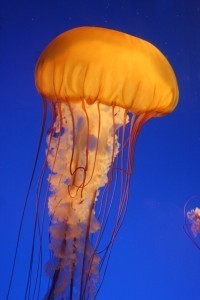 Margaret Atwood (in)famously referred to science fiction as "talking squids in outer space," a remark to which I would take great umbrage if not for the fact that my DAW novel Lost in Translation contains a character, Karak, master of the Guild of Translators, described thusly:
Margaret Atwood (in)famously referred to science fiction as "talking squids in outer space," a remark to which I would take great umbrage if not for the fact that my DAW novel Lost in Translation contains a character, Karak, master of the Guild of Translators, described thusly:
Free of the watersuit and its exoskeleton, his shape was nothing bipedal at all; his almost globular, iridescent body, from which writhed six locomotive tentacles and six manipulators, moved through the water with boneless grace, gill-slits pulsating below the fringe of feeding-tentacles that encircled his beak. It seemed odd to hear perfect home-planet S'sinn emerging from that alien mouth.
For all intents and purposes, then, Lost in Translation did indeed feature a talking squid in outer space. Which means a) I really shouldn't bad-mouth Margaret Atwood's definition, and b) Margaret Atwood reads my stuff!
What Atwood did not mention, and perhaps few people realize, is that everything is improved with the addition of squid. As my daughter and I have discovered: take any title, replace a word with "squid," and the result is instant merriment!
Don't believe me? Consider this list of titles, the top 25 movies in the list of the top 250 movies of all time as voted on by users of the Internet Movie Database:
The Squidshank Redemption
The Squidfather
The Squidfather: Part II
The Good, the Bad and the Squid
Squid Fiction
Schindler's Squid
12 Angry Squid
Squidception
One Flew Over the Squid's Nest
The Dark Squid
Squid Wars: Episode V – The Squid Strikes Back
The Lord of the Squid: The Return of the Squid
Seven Squid
Squid Club
Squid Wars: Episode IV – A New Squid
Squidfellas
Casasquida
City of Squid
The Lord of the Squid: The Fellowship of the Squid
Once Upon a Squid in the West
Rear Squid
Raiders of the Lost Squid
The Squidrix
Squidcho
The Usual Squid
Best of all, this even (or especially) works with the titles of Margaret Atwood novels, like so:
The Edible Squid
Squidding
Lady Squid
Life Before Squid
Bodily Squid
The Handsquid's Tale
Squid's Eye
The Robber Squid
Alias Squid
The Blind Squid
Oryx and Squid
The Squidiad
The Year of the Squid
See what I mean? So infallible is this method of amusing oneself (if one is me, anyway, or my nine-year-old daughter), that I have become convinced that "squid" is the funniest word in the English language.
Squid! It's not just for breakfast any more.
(The photo: Not a squid, but a jellyfish, at the Vancouver Aquarium.)
February 16, 2011
Steamed-Rice Mommy's Coming to Town
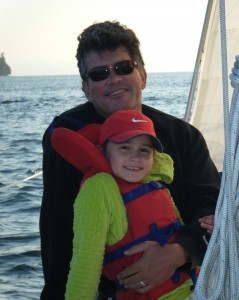 While looking for something entirely different in my computer files (The Mixed-Up Files of Edward C. Willett, which would be a great title for a book if someone hadn't already kind of gotten there first), I came across this audio recording from a couple of years ago, when my daughter was seven.
While looking for something entirely different in my computer files (The Mixed-Up Files of Edward C. Willett, which would be a great title for a book if someone hadn't already kind of gotten there first), I came across this audio recording from a couple of years ago, when my daughter was seven.
Ladies and gentlemen, I present the Willett Duo with their rendition of "Steamed-Rice Mommy's Coming to Town," inspired by the gripping real-life saga of…supper.
It provides 100 percent of your dailycuteness requirement!
Click to play: Steamed Rice Mommy's Coming to Town
(The photo: Me and Alice, of course.)
February 15, 2011
The thinking cap
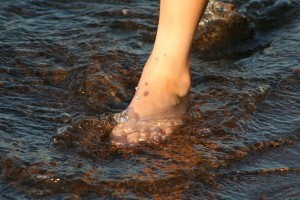 You know, it's not easy being a writer.
You know, it's not easy being a writer.
Oh, I know, it doesn't rank up there with, say, coal miner in physical difficulty or neurosurgeon in mental difficulty, but where it probably has it over both of them is in creative difficulty: the pressure to constantly come up with something new.
Heck, as a science fiction and fantasy writer, I'm expected to create entire worlds, whole solar systems, mythical creatures and believable characters out of nothing more than my own brain cells.
Wouldn't it be great if there were some way to artificially stimulate creativity?
Turns out, there may be.
In a paper published earlier this month in PLoS One, an online scientific journal, researchers Richard Chi and Allan Snyder from the Centre for the Mind at the University of Sydney reported on a study they conducted that seemed to show that people receiving electrical stimulation of the anterior temporal lobes of the brain (located, basically, just above the ears) found it easier to figure out how to solve a difficult puzzle than those who didn't receive that stimulation.
To provide the electrical stimulation, the scientists created what the press release from the journal calls "an electric thinking cap." (Consisting of two sponge electrodes soaked in salt water fastened to the head by a rubber strap, in order to set up a weak current through the targeted part of the brain, it's more properly called a tDCS device, for "transcranial direct current stimulation".)
The puzzle presented to the participants involved correcting a false arithmetic statement presented in Roman numerals constructed from matchsticks. The participants had to figure out how to make the statement correct by moving a single matchstick from one position to another: for example, turning an X into a V.
The results: while only 20 percent of non-thinking-capped participants could figure out a complex version of the problem (after practicing with a series of easier problems) in the six minutes allowed, 60 percent of those receiving stimulation managed it.
Past research has indicated that the left anterior temporal lobe (ATL) is associated with solving problems using known, tried-and-true methods, while the right ATL is associated with what is commonly called "thinking outside the box": coming up with new ways to solve problems.
The researchers placed their electrodes on the subjects' heads so that the flow of current suppressed activity in the left ATL, while enhancing it in the right.
The brain is always trying to find a balance between "exploration and exploitation," as neuroscientist David Eagleman of Baylor College of Medicine puts it: in other words, between finding new ways of doing things and using methods it has already figured out.
Eagleman points out that there's a downside to "thinking outside the box" in survival terms: "The only way an animal can get by…is using what it has learned in the past and coming up with new solutions," he says. "If you were an animal in the wild trying to constantly come up with new solutions to every problem…you'd probably starve to death.
"What this study shows is that you can tip the balance of this battle in favor of exploring new possibilities."
One uncertainty is whether the increase in creativity arose because of the enhancement of activity in the right ATL or the suppression of it in the left ATL, or if it was a combination of the two.
However, according to Snyder, the research was inspired by reports of accident victims who, after damaging the left side of their brains, suddenly "burst out into the arts or other types of creative activities," which would seem to imply suppressing the left ATL alone is enough to enhance creativity.
So, does this mean I and other types who depend on being creative for our livelihoods will be able to buy a thinking cap at Staples any time soon?
Alas, no. But as research continues, who knows? Snyder isn't discounting it. Although the science is in its infancy, he says the "thinking cap" has potential applications in problem-solving…and, yes, in the arts.
Perhaps, in the future, there will no longer be any need for writers to gaze mournfully into space, take long walks in the rain, or starve in garrets as they seek their muse.
Instead, they'll slap on their "We 'R' A Muse" patented electromagnetic thinking cap (available in a variety of designer colors!), plug it in, and pop out a masterpiece by supper.
Not very romantic, I admit. But it sure would take the pressure off.
The photo: Barefoot in Bemidji.
February 9, 2011
Blue Fire or bust
 Those who have followed my occasional series "The First Sentence I Wrote Today," a.k.a. on Twitter as TFSIWT, will know that I have been working, interminably, on a young adult fantasy novel called Blue Fire. I've written it. I've re-written it. I've re-re-written it. It first came in at a ridiculous length, so I chopped 30 or 40,000 words out of it. Now I'm on the final pass through it before submitting it (there's an editor interested in taking a look, but only when it's complete). And I'm desperately trying to get it out of my hair so I can focus on other projects with looming deadlines (hi, Magebane!).
Those who have followed my occasional series "The First Sentence I Wrote Today," a.k.a. on Twitter as TFSIWT, will know that I have been working, interminably, on a young adult fantasy novel called Blue Fire. I've written it. I've re-written it. I've re-re-written it. It first came in at a ridiculous length, so I chopped 30 or 40,000 words out of it. Now I'm on the final pass through it before submitting it (there's an editor interested in taking a look, but only when it's complete). And I'm desperately trying to get it out of my hair so I can focus on other projects with looming deadlines (hi, Magebane!).
So, this is short. Today is all about Blue Fire. With any luck, I may finish it up today.
(I feel like the Little Engine Who Could. "I think I can, I think I can, I think I can…")
Just for fun, though, here's the opening of Blue Fire as it currently stands:
The night dripped, and Petra dripped with it.
Water poured off his steel helmet and down the back of his neck. His blue woolen cloak hung heavy as lead from his mail-clad shoulders. His boots squelched with every step and his damp leather trousers chafed his thighs.
Despite his gloves, his fingers had gone numb on his third circuit of the Fire Curtain surrounding the Grand Temple of Vekk–and he was currently completing his fourteenth.
They'd be warm if I could wrap them around Cort's neck, he thought. His roommate and fellow Priest-Apprentice had gotten him into this mess by trying to smuggle a girl into the Temple. Cort had promised the girl he'd "show her the sights of the Temple." But one of the Temple gate guards had seen a bare foot protruding from under the cabbages Cort and Petra had been sent to the market to fetch, and so…
…so, here Petra was, cold, wet and miserable. He'd originally thought a week of midnight guard duty was better than the week of kitchen drudgery to which Cort had been sentenced. But Cort was warm and dry in his bed right now. And probably laughing at me, Petra thought gloomily.
He swiped his sodden arm across his runny nose, turned the corner to start his trek down the backside of the Temple for the fifteenth time…and stopped.
The Temple's stone wall, black and blank, loomed to his left. From high above flashes like distant lightning occasionally lit the gloom, stray bits of the mystical Blue Fire that poured from the Temple Spire into the magical Hearths all around City Primaxis, which in turn poured Blue Fire into sparkglobes for light and stoves for cooking and heat.
To his right ran the Curtain, shimmering blue like an aurora brought to earth, interrupted every twenty feet by a thick square post of black wood. Each post bore, on the side facing the Temple, a magical sigil, a complex symbol laboriously carved by hand, then filled with molten gold.
A crosspiece topped each post, and from each end of the crosspieces, one inside and one outside the Curtain, hung sparkglobes, glass spheres containing bright fluttering tongues of Blue Fire.
In the rain, the sparkglobes quickly devolved into a double row of misty blobs as they marched away from Petra down the two-hundred-yard length of the Temple's backside…a double row interrupted, two-thirds of the way down, by a patch of darkness…
It is my sincerest hope you may one day get to read the rest. But first, I've got to finish it!
So…back to work.
The photo: Ferry at Horseshoe Bay, B.C.
February 8, 2011
Biddle-dee-diddle-dee-dee!
By "that," I mean the process of getting this new computer up and running to my satisfaction. Yes, the new monitor arrived last week, and I spent a few happy (well, mostly happy) hours with plug-ins and cables and drives (oh, my!), losing hours of productivity in order to get a device that is supposed to enhance my productivity to the point where I can actually be productive on it. But it is ever thus, and things seem to be in good working order now, with the old computer still standing by and ready to go in case I suddenly realize I've forgotten to transfer something I really need. (Which has already happened about three times.)
But that "that" isn't the only "that" that I meant when I said "that" was fun. The other "that" that was fun was Regina Lyric Musical Theatre's annual fundraising brunch, the first of two installments of which took place on Sunday at the Hotel Saskatchewan Radisson Plaza.
I've been involved with Regina Lyric Musical Theatre (formerly called Regina Lyric Light Opera Society, and henceforth to be referred to simply as "Lyric" for the sake of my typing fingers), for (gulp!) more than 20 years ago.
Back when I lived in Weyburn, I was one of the founding members of Crocus 80 Theatre (formed in 1980, in case you couldn't guess), and eventually rose to the presidency of that august community theatre troupe. When I came to Regina in late 1988 I naturally expected that my ongoing theatrical activities would be focused on Regina Little Theatre, one of the oldest little theatres in Canada…but, see, Lyric did musicals. And I sing. And so…Lyric became my primary theatrical home, rather than RLT (though I have acted in and directed RLT productions over the years).
I was almost immediately drafted to the board of Lyric, and eventually became president, and for many years, I was in every single Lyric production. I can't say that any more, and I'm no longer on the board, but I continue to be publicity director and I also design posters and programs (oh, and look after the website). And I do perform frequently with Lyric…which is what I was doing Sunday.
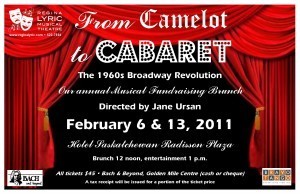 Lyric's musical brunch is a terrific event that offers a great brunch, followed by more than an hour of Broadway-based entertainment. It's been directed for many years by Jane Ursan (although I directed it a couple of times about a decade ago), and each year she puts together a fabulous line-up of songs, all built around a theme. Sometimes it's been a particular composer (Stephen Sondheim, Leonard Bernstein), but this year it was called From Camelot to Cabaret: The 1960s Broadway Revolution, and featured songs from the amazing shows of that decade. The show features songs from Camelot, Bye, Bye Birdie, Do Re Mi, The Fantasticks, How to Succeed in Business Without Really Trying, 110 in the Shade, A Funny Thing Happened on the Way to the Forum, Oliver, Hello, Dolly!, Fiddler on the Roof, Funny Girl, Sweet Charity, You're a Good Man, Charlie Brown and many more, finishing with a rousing rendition of a medley from Hair. (That medley is notable from my point of the view for the fact that I play tambourine on "Let the Sun Shine In." Tambourines, I have discovered, hurt. The palm I banged it against was sore for a day, my right arm felt like it would fall off, and one night at rehearsal I came within about two minutes of tambourining of developing a blister on my thumb. Considering that, as someone joked the other day, the tambourine was invented so bands had an excuse to put a pretty girl on stage, the fact I'm playing it is odd, to say the least!)
Lyric's musical brunch is a terrific event that offers a great brunch, followed by more than an hour of Broadway-based entertainment. It's been directed for many years by Jane Ursan (although I directed it a couple of times about a decade ago), and each year she puts together a fabulous line-up of songs, all built around a theme. Sometimes it's been a particular composer (Stephen Sondheim, Leonard Bernstein), but this year it was called From Camelot to Cabaret: The 1960s Broadway Revolution, and featured songs from the amazing shows of that decade. The show features songs from Camelot, Bye, Bye Birdie, Do Re Mi, The Fantasticks, How to Succeed in Business Without Really Trying, 110 in the Shade, A Funny Thing Happened on the Way to the Forum, Oliver, Hello, Dolly!, Fiddler on the Roof, Funny Girl, Sweet Charity, You're a Good Man, Charlie Brown and many more, finishing with a rousing rendition of a medley from Hair. (That medley is notable from my point of the view for the fact that I play tambourine on "Let the Sun Shine In." Tambourines, I have discovered, hurt. The palm I banged it against was sore for a day, my right arm felt like it would fall off, and one night at rehearsal I came within about two minutes of tambourining of developing a blister on my thumb. Considering that, as someone joked the other day, the tambourine was invented so bands had an excuse to put a pretty girl on stage, the fact I'm playing it is odd, to say the least!)
Most years I've sung a solo, but this year for a change I was in a trio, "Two Ladies" from Cabaret ("Biddle-dee-diddle-dee, two ladies, biddle-dee-diddle-dee-dee, two ladies, biddle-dee-diddle-dee-dee, and I'm the only man…ja!"), a song whose character is best summed up by pointing out it takes place entirely behind a blanket and I finish it shirtless and with my face covered in lipstick.
It's a fun song, and it was particularly fun because one of the the two ladies who sang it with me was my real-life lady, my wife, Margaret Anne.
And what made that special was that, although there are many reasons I am fond of Lyric, the reason that stands head and shoulders and an Everest-sized mountain peak above the others is that it was through Lyric that I met Margaret Anne.
And , in turn, means that without Lyric, I would not have my amazing, beautiful, wonderful daughter, Alice…whose picture, looking pensive, adorns the start of this post.
If you happen to be in the Regina area, I hope you'll consider coming out to this Sunday's repeat performance. Brunch is at 12 noon, and the singing follows at about 1:15. Tickets are $45, and available from Bach & Beyond in the Golden Mile Centre. I'd love to see you there!
Biddle-dee-biddle-dee-dee!
The photo: My daughter, Alice, age 9.
February 4, 2011
Blue's clues
It hasn't always been so. As a child, I was of course immersed in the done-to-death running gags of the cartoon world, where smelly cheese (always Limburger, for some reason) seemed to be thought of as a sure-fire laugh riot.
Outside of the cartoon world, I simply wasn't exposed to blue cheese. My favorite childhood cheese was Velveeta. Maybe mild cheddar. Blue cheese? Fuggetaboudit.
But somewhere along the way I developed a taste for it, to the point where I eat it almost daily on my lunchtime sandwics. And I'm always willing to try a new blue cheese.
Now, to be fair to those long-ago cartoon creators, blue cheese really is smelly. In fact, as a general rule of thumb, the smellier the better.
How smelly can blue cheese be? A few years ago at the International Wine and Food Festival at the Banff Springs Hotel, Spain was being featured. During a tasting of Spanish cheeses that included a cave-ripened blue, our host told the tale of the American GI who, during the Second World War, came across a cave somewhere in Europe that smelled so horrible he was certain it must be stacked with rotting corpses.
Rather than go into such a disgusting place, he stood outside and scoured it out thoroughly with his flamethrower. The result? A cave full of well-toasted blue cheese!
Because I, unlike that possibly apocryphal soldier, like blue cheese, my eye was caught this week by a news item from the University of Nottingham and the University of Northampton, whose researchers are working with Stichelton Dairy, local makers of a fine unpasteurized blue cheese similar to Stilton, to learn more about blue cheese…and make it even better.
All cheese production follows the same six basic steps. First comes acidification: a starter culture of microorganisms is added to the milk to change lactose (milk sugar) into lactic acid. This begins the process of turning milk from a liquid to a solid.
Next, rennet is added to further encourage the milk to solidify, a process called coagulation. This leads to Miss Muffet's favorite food, curds and whey.
The curds are cut, which encourages them to expel the liquid they contain, called whey. In general, cutting curds small leads to a harder cheese, while the curds of soft cheeses like Brie are hardly cut at all.
Next comes salting. Salt both enhances flavor and serves as a preservative, and encourages the formation of a rind. It may be added to the curd or rubbed on the outside of the wheel of cheese. Sometimes, the whole cheese is bathed in brine.
Speaking of wheels of cheese, shaping is also part of the process: the cheese is put into a mold, and pressed to expel any remaining liquid.
Finally comes ripening, or, if you want to sound more cheese-knowledgeable (or possibly slightly pretentious), "affinage." Affinage takes place in a climate-controlled environment, and it's during this stage that a blue cheese turns blue, from molds already present in the air, sprayed onto the cheese, or injected into it.
But molds are only some of the microorganisms, collectively called "secondary flora," active during affinage.
In fact, previous research has shown that in complex cheeses like Stilton this secondary flora varies from part to part of the cheese. The core will have one kind, the blue veins another, and the rind still another. But only some of these microflora are beneficial. Some may actually be antifungal, preventing the mold that makes blue cheese blue from growing.
Although their research has just begun, the English scientists hope to gain a better understanding of which secondary flora contribute to the development of flavor, and which need to be controlled. As a side benefit, the researchers hope to turn up new, natural antifungal co[pounds, which could be very useful for all those other food products where mold is a bad thing (which, besides cheese, is most of them).
If the research results in better blue cheese, I'm all for it. And as for the smell…well, it's really not so bad once you get used to it.
At least, I've never felt the urge to flamethrower my refrigerator.
The photo: Chateau Frontenac, Quebec City.
February 3, 2011
School Library Journal praises Song of the Sword
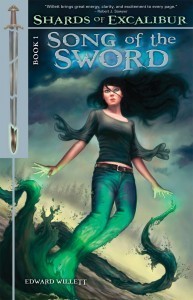 A nice new review of Song of the Sword in the important School Library Journal. After a very nice synopsis, reviewer Michele Shaw says:
A nice new review of Song of the Sword in the important School Library Journal. After a very nice synopsis, reviewer Michele Shaw says:
"This is a fantasy of epic proportions, with the perfect blend of suspense; well-developed, likable characters; and a touch of sarcastic humor. Ariane and Wally find four shards and the hilt of the sword, ensuring readers that this is just the beginning of the fantastical journey."


